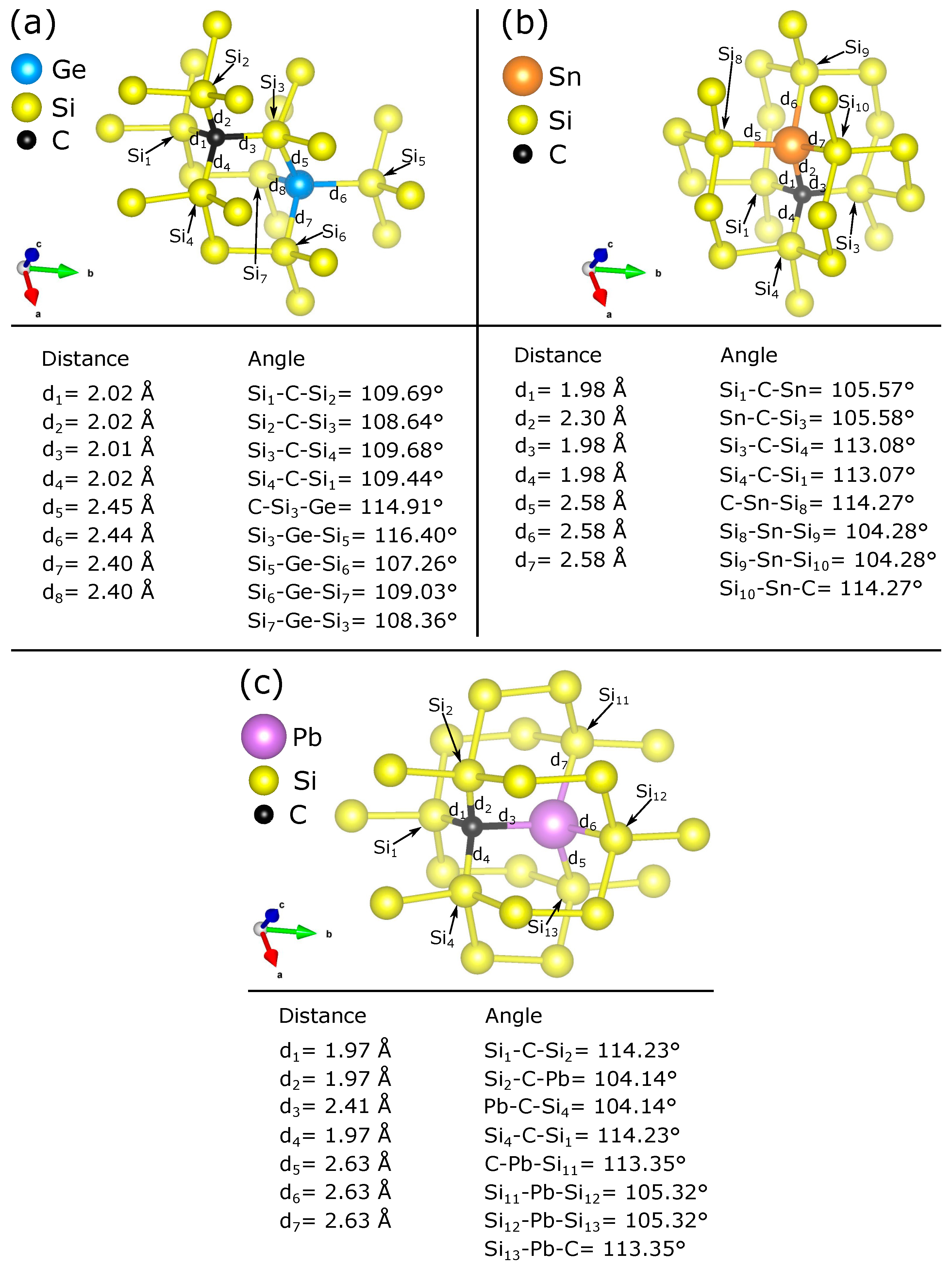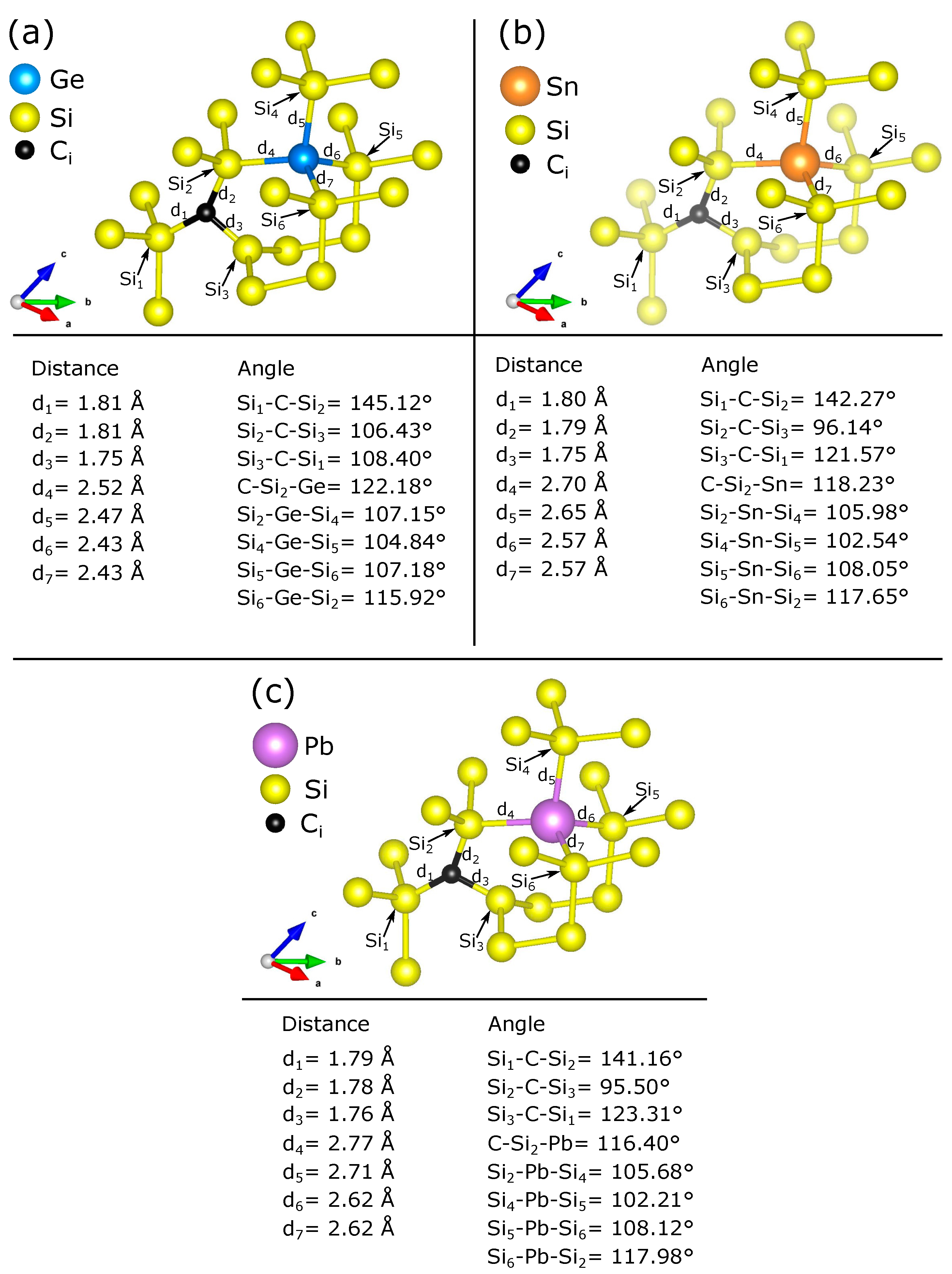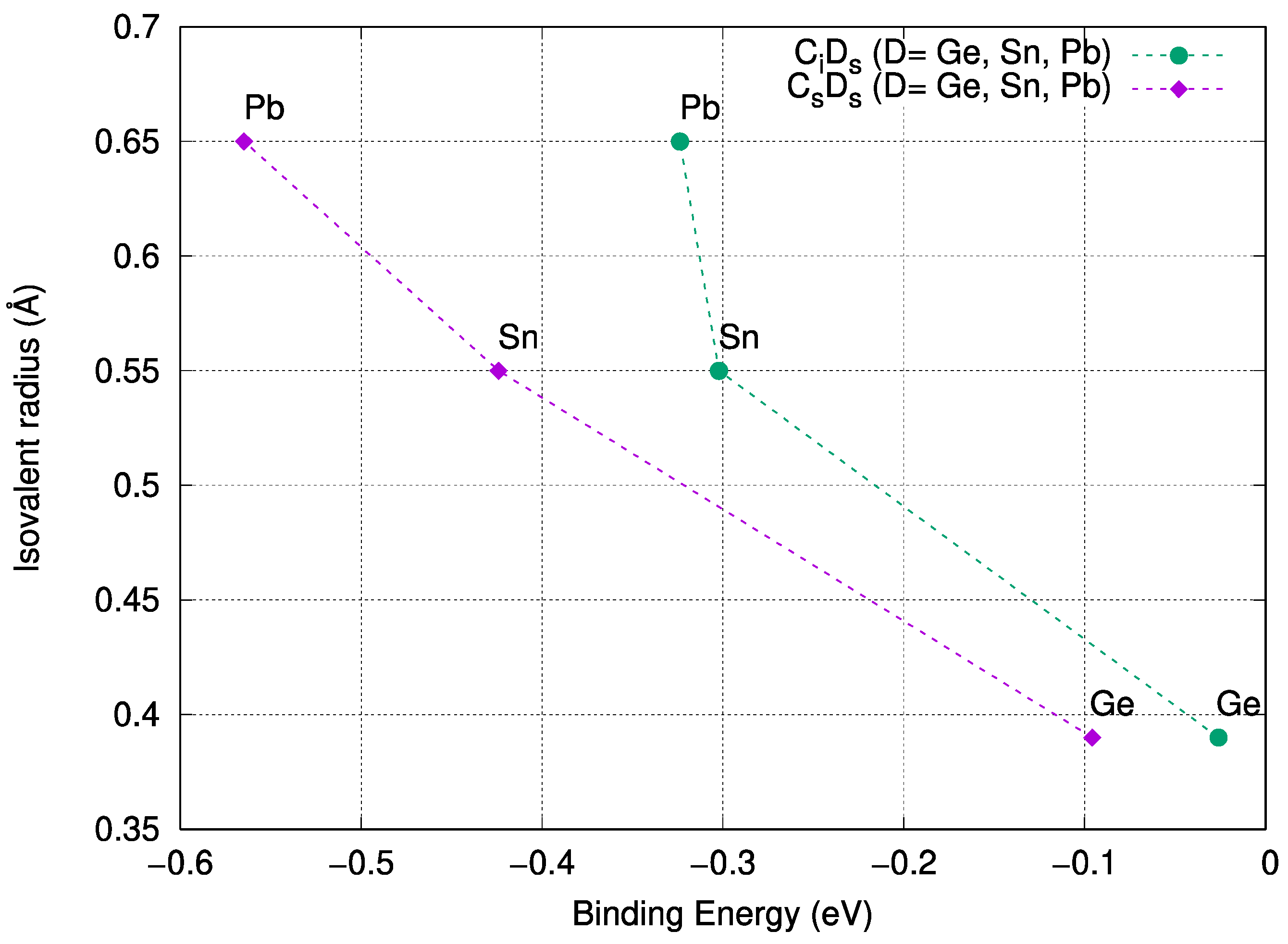Carbon-Isovalent Dopant Pairs in Silicon: A Density Functional Theory Study
Abstract
1. Introduction
2. Computational Methodology
3. Results
3.1. Carbon Substitutional-Isovalent Dopant Defect Pairs
3.2. Carbon Interstitial-Isovalent Dopant Defect Pairs
4. Discussion
5. Conclusions
Author Contributions
Funding
Data Availability Statement
Conflicts of Interest
References
- Yang, D. (Ed.) Handbook of Photovoltaic Silicon; Springer: Berlin/Heidelberg, Germany, 2019. [Google Scholar]
- Udvarheylyi, P.; Somogyi, B.; Thiering, G.; Gali, A. Identification of a Telecom Wavelength Single Photon Emitter in Silicon. Phys. Rev. Lett. 2021, 127, 196402. [Google Scholar] [CrossRef]
- Liu, W.; Ivanov, V.; Jhuria, K.; Ji, Q.; Persaud, A.; Redjem, W.; Simoni, J.; Zhiyenbayev, Y.; Kante, B.; Lopez, J.G.; et al. Quantum Emitter Formation Dynamics and Probing of Radiation-Induced Atomic Disorder in Silicon. Phys. Rev. Appl. 2023, 20, 014058. [Google Scholar] [CrossRef]
- Bisogni, M.G.; Del Guerra, A.; Belcari, N. Medical applications of silicon photomultipliers. Nucl. Inst. Methods Phys. Res. A 2019, 926, 118–128. [Google Scholar] [CrossRef]
- Jia, X.; He, L. Noise-based analysis of the reliability of silicon solar cells. AIP Adv. 2021, 11, 045206. [Google Scholar] [CrossRef]
- Freysoldt, C.; Grabowski, B.; Hichel, T.; Neugebauer, J.; Janotti, G.; van de Walle, G. First-principles calculations for point defects in solids. Rev. Mod. Phys. 2014, 86, 253–305. [Google Scholar] [CrossRef]
- McCluskey, M.D.; Jannoti, A. Defects in Semiconductors. J. Appl. Phys. 2020, 127, 190401. [Google Scholar] [CrossRef]
- Drabold, D.A.; Estreicher, S.K. (Eds.) Theory of Defects in Semiconductors; Topics in Applied Physics; Springer: Berlin/Heidelberg, Germany, 2007; Volume 14. [Google Scholar]
- Pichler, P. Intrinsic Point Defects, Impurities, and Their Diffusion in Silicon; Springer: Wien, Austria, 2004. [Google Scholar]
- Yu, X.; Chen, J.; Ma, X.; Yang, D. Impurity engineering of Czochralski silicon. Mater. Sci. Eng. R 2013, 74, 1–33. [Google Scholar] [CrossRef]
- Chen, J.; Yang, D. Impurity engineering for germanium-doped Czochralski silicon wafer used for ultra-large scale integrated circuit. Phys. Stat. Sol. C 2009, 6, 625. [Google Scholar] [CrossRef]
- Londos, C.A.; Andrianakis, A.; Emtsev, V.V.; Ohyama, H. Radiation-induced defects in Czochralski-grown silicon containing carbon and germanium. Semicond. Sci. Technol. 2009, 24, 075002. [Google Scholar] [CrossRef][Green Version]
- Chroneos, A.; Londos, C.A.; Sgourou, E.N.; Pochet, P. Point defect engineering strategies to suppress A-center formation in silicon. Appl. Phys. Lett. 2011, 99, 241901. [Google Scholar] [CrossRef]
- Sgourou, E.N.; Timerkaeva, D.; Londos, C.A.; Aliprantis, D.; Chroneos, A.; Calliste, D.; Pochet, P. Impact of isovalent doping on the trapping of vacancy and interstitial related defects in Si. J. Appl. Phys. 2013, 113, 113506. [Google Scholar] [CrossRef]
- Newman, R.C. Oxygen, Carbon, Hydrogen and Nitrogen in Crystalline Silicon. In Proceedings of the Materilas Research Society Symposia Proceedings, Boston, MA, USA, 2–5 December 1985; Mikkelsen, J.C., Jr., Pearton, S.J., Corbett, J.W., Pennycook, S.J., Eds.; 1986; Volume 59, p. 403. [Google Scholar]
- Davies, G.; Newman, R.C. Carbon in Crystalline Silicon. In Handbook on Semiconductors; Mahajan, S., Ed.; Elsevier Science B.V.: Amsterdam, The Netherlands, 1994; Volume 3, p. 1557. [Google Scholar]
- Londos, C.A.; Sgourou, E.N.; Chroneos, A.; Emtsev, V.V. Carbon, oxygen and intrinsic defect interactions in germanium-doped silicon. Semicond. Sci. Technol. 2011, 26, 105024. [Google Scholar] [CrossRef]
- Londos, C.A.; Aliprantis, D.N.; Antonaras, G.; Potsidi, M.S.; Angeletos, T. Experimental and theoretical study of the C4 defect in neutron irradiated silicon. J. Appl. Phys. 2018, 123, 145702. [Google Scholar] [CrossRef]
- Wang, H.; Chroneos, A.; Londos, C.A.; Sgourou, E.N.; Schwingenschlogl, U. Carbon related defects in irradiated silicon revisited. Sci. Rep. 2014, 4, 4909. [Google Scholar] [CrossRef] [PubMed]
- Potsidi, M.S.; Kuganathan, N.; Chroneos, A.; Christopoulos, S.-R.G.; Angeletos, T.; Sarlis, N.V.; Londos, C.A. Substitutional carbon-dioxygen center in irradiated silicon. Mater. Sci. Semicond. Proc. 2021, 127, 105661. [Google Scholar] [CrossRef]
- Wang, H.; Chroneos, A.; Londos, C.A.; Sgourou, E.N.; Schwingenschlogl, U. G-centers in irradiated silicon revisited: A screened hybrid density functional theory approach. J. Appl. Phys. 2014, 115, 183523. [Google Scholar] [CrossRef]
- Potsidi, M.; Londos, C.A. The CiCs(SiI) defect in silicon: An infrared spectroscopy study. J. Appl. Phys. 2006, 100, 033523. [Google Scholar] [CrossRef]
- Londos, C.A.; Chroneos, A.; Sgourou, E.N.; Panagiotidis, I.; Angeletos, T.; Potsidi, M.S. Comparative Study of Oxygen- and Carbon-Related Defects in Electron Irradiated Cz–Si Doped with Isovalent Impurities. Appl. Sci. 2022, 12, 8151. [Google Scholar] [CrossRef]
- Deak, P.; Udvarhelyi, P.; Thiering, G.; Smith, A. The kinetics of carbon pair formation in silicon prohibits reaching thermal equilibrium. Nat. Commun. 2023, 14, 361. [Google Scholar] [CrossRef]
- Tan, T.Y.; Taylor, W.J. Mechanisms of Oxygen precipitation: Some quantitative aspects, in Oxygen in Silicon. In Semiconductor and Semimetals; Shimura, F., Ed.; Springer: Berlin/Heidelberg, Germany, 1994; Volume 42, pp. 353–390. [Google Scholar]
- Kissinger, G. Oxygen Impurity in Crystalline Silicon. In Handbook of Photovoltaic Silicon; Yang, D., Ed.; Springer: Berlin/Heidelberg, Germany, 2019. [Google Scholar]
- Wu, Y.; Yunn, S.; Qiu, X.; Zhu, H.; Qian, J.; Yang, D. Impact of carbon co-doping on the performance of crystalline silicon solar cells. Sol. Energy Mater. Sol. Cells 2016, 154, 94. [Google Scholar] [CrossRef]
- Taishi, T.; Huag, X.; Yonenaga, I.; Hashikawa, K. Dislocation behavior in heavily germanium-doped silicon crystal. Mater. Sci. Semicond. Process. 2002, 5, 409–412. [Google Scholar] [CrossRef]
- Chen, J.; Yang, D.; Ma, X.; Zeng, Z.; Tian, D.; Li, L.; Que, D.; Gong, L. Influence of germanium doping on the mechanical strength of Czochralski silicon wafers. J. Appl. Phys. 2008, 103, 123521. [Google Scholar] [CrossRef]
- Dashevskii, M.Y.; Dokuchaeva, A.A.; Sadilov, S.I. On the solubility of oxygen in silicon doped with germanium. Inorg. Mater. 1989, 25, 580. [Google Scholar]
- Chen, J.; Yang, D.; Li, H.; Ma, X.; Que, D. Enhancement effect of germanium on oxygen precipitation in Czochralski silicon. J. Appl. Phys. 2006, 99, 073509. [Google Scholar] [CrossRef]
- Chen, J.; Yang, D.; Ma, X.; Que, D. Rapid-thermal-anneal-based internal gettering for germanium-doped Czochralski silicon. Appl. Phys. A 2009, 94, 905–910. [Google Scholar] [CrossRef]
- Carbonaro, C.M.; Fiorentini, V.; Bernardini, F. Stability of Ge-related point defects and complexes in Ge-doped SiO2. Phys. Rev. B 2002, 66, 233201. [Google Scholar] [CrossRef]
- Chen, J.; Yang, D.; Li, H.; Ma, X.; Tian, D.; Li, L.; Que, D. Crystal-originated particles in germanium-doped Czochralski silicon crystal. J. Cryst. Growth. 2007, 306, 262–268. [Google Scholar] [CrossRef]
- Wang, P.; Yu, X.; Chen, P.; Li, X.; Yang, D.; Chen, X.; Huang, Z. Germanium-doped Czochralski silicon for photovoltaic applications. Sol. Energy Mater. Sol. Cells 2011, 95, 2466. [Google Scholar] [CrossRef]
- Chroneos, A.; Sgourou, E.N.; Londos, C.A.; Schwingenschlogl, U. Oxygen defect processes in silicon and silicon germanium. Appl. Phys. Rev. 2015, 2, 021306. [Google Scholar] [CrossRef]
- Londos, C.A.; Andrianakis, A.; Sgourou, E.N.; Emtsev, V.; Ohyama, H. Effect of germanium doping on the annealing characteristics of oxygen and carbon-related defects in Czochralski silicon. J. Appl. Phys. 2010, 107, 093520. [Google Scholar] [CrossRef]
- Voronkov, V.V.; Falster, R.; Londos, C.A.; Sgourou, E.N.; Andrianakis, A.; Ohyama, H. Production of vacancy-oxygen defect in electron irradiated silicon in the presence of self-interstitial-trapping impurities. J. Appl. Phys. 2011, 110, 093510. [Google Scholar] [CrossRef]
- Zhang, J.; Tse, K.; Wong, M.; Zhang, Y.; Zhu, J. A brief review of co-doping. Front. Phys. 2016, 11, 117405. [Google Scholar] [CrossRef]
- Londos, C.A.; Sgourou, E.N.; Hall, D.; Chroneos, A. Vacancy-oxygen defects in silicon: The impact of isovalent doping. J. Mater. Sci. Mater. Electron. 2014, 25, 2395–2410. [Google Scholar] [CrossRef]
- Londos, C.A.; Andrianakis, A.; Sgourou, E.N.; Emtsev, V.V.; Ohyama, H. IR studies of the impact of Ge doping on the successive conversion of Von defects in Czochralski-Si containing carbon. J. Appl. Phys. 2009, 105, 123508. [Google Scholar] [CrossRef]
- Brelot, A. Tin as a Vacancy Trap in Silicon at Room Temperature. IEEE Trans. Nucl. Sci. 1972, 19, 220–223. [Google Scholar] [CrossRef]
- Watkins, G.D. Defects in irradiated silicon: EPR of the tin-vacancy pair. Phys. Rev. B 1975, 12, 4383. [Google Scholar] [CrossRef]
- Chroneos, A.; Londos, C.A.; Sgourou, E.N. Effect of tin doping on oxygen- and carbon-related defects in Czochralski silicon. J. Appl. Phys. 2011, 110, 093507. [Google Scholar] [CrossRef]
- Chroneos, A.; Londos, C.A. Interaction of A-centers with isovalent impurities in silicon. J. Appl. Phys. 2010, 107, 093518. [Google Scholar] [CrossRef]
- Clays, C.; Simoen, E.; Neimash, V.B.; Kraitchinskii, A.; Krasko, M.; Puzenko, O.; Blondeel, A.; Clauws, P. Tin Doping of Silicon for Controlling Oxygen Precipitation and Radiation Hardness. J. Electrochem. Soc. 2001, 148, G738. [Google Scholar] [CrossRef]
- Lavrov, E.V.; Fanciully, M.; Kaukonen, M.; Jones, R.; Briddon, P.R. Carbon-tin defects in silicon. Phys. Rev. B 2001, 64, 125212. [Google Scholar] [CrossRef]
- Linstrom, G.; Moll, M.; Fretwrst, E. Radiation hardness of silicon detectors—A challenge from high-energy physics. Nucl. Instum. Meth. Phys. Res. A 1999, 426, 1–15. [Google Scholar] [CrossRef]
- Canham, L.T.; Dyball, M.R.; Barraclough, K.G. A study of carbon-implanted silicon for light-emitting diode fabrication. Mater. Sci. Eng. B 1989, 4, 95. [Google Scholar] [CrossRef]
- Caliste, D.; Rushchanskii, K.Z.; Pochet, P. Vacancy-mediated diffusion in biaxially strained Si. Appl. Phys. Lett. 2011, 98, 031908. [Google Scholar] [CrossRef]
- Chroneos, A.; Jiang, C.; Grimes, R.W.; Schwingenschlögl, U.; Bracht, H. E centers in ternary Si1-x-yGexSny random alloys. Appl. Phys. Lett. 2009, 95, 112101. [Google Scholar] [CrossRef]
- David, M.L.; Simoen, E.; Clays, C.; Neimash, V.B.; Krasko, M.; Kraitchinskii, A.; Voytovych, V.; Kabaldin, A.; Barbot, J.F.J. Electrically active defects in irradiated n-type Czochralski silicon doped with group IV impurities. Phys. Condens. Mater. 2005, 17, S2255. [Google Scholar] [CrossRef]
- Neimash, V.B.; Voitovych, V.V.; Kras’ko, M.; Kraitchinskii, A.M.; Kabaldin, O.M.; Pavlos’kyi, Y.V.; Tsmots’, V.M. Formation of Radiation-induced Defects in n-Si with Lead and Carbon Impurities. Ukr. J. Phys. 2005, 50, 1273. [Google Scholar]
- Londos, C.A.; Aliprantis, D.N.; Sgourou, E.N.; Chroneos, A.; Pochet, P. Formation and evolution of oxygen-vacancy clusters in lead and tin doped silicon. J. Appl. Phys. 2012, 111, 123508. [Google Scholar] [CrossRef]
- Londos, C.A.; Sgourou, E.N.; Chroneos, A. Defect engineering of the oxygen-vacancy clusters formation in electron irradiated silicon by isovalent doping: An infrared perspective. J. Appl. Phys. 2012, 112, 123517. [Google Scholar] [CrossRef]
- Milants, K.; Verheyden, J.; Balancira, T.; Deweerd, W.; Pattyn, H.; Bukshpan, S.; Williamson, D.L.; Vermeiren, F.; van Tandeloo, G.; Viakken, C.; et al. Size distribution and magnetic behavior of lead inclusions in silicon single crystals. J. Appl. Phys. 1997, 81, 2148. [Google Scholar] [CrossRef]
- Lavrov, E.V.; Fanciully, M. Interstitial carbon-substitutional tin center in silicon (?). Phys. B. Condens. Matter 2001, 302–303, 263. [Google Scholar] [CrossRef]
- Khirunenko, L.I.; Kobzar, O.O.; Pomozov, Y.V.; Sosnin, M.G.; Tripachko, M.O.; Abrosimov, N.V.; Riemann, H. Interstitial-related reactions in silicon doped with isovalent impurities. Phys. B Condens. Matter 2003, 340, 546. [Google Scholar] [CrossRef]
- Khirunenko, L.I.; Kobzar’, O.A.; Pomozov, Y.V.; Sosnin, M.G.; Tripachko, N.A. The role of tin in reactions involving carbon interstitial atoms in irradiated silicon. Semiconductors 2003, 37, 288. [Google Scholar] [CrossRef]
- Londos, C.A.; Sgourou, E.N.; Timerkaeva, D.; Chroneos, A.; Emtsev, V.V. Impact of isovalent doping on radiation defects in silicon. J. Appl. Phys. 2013, 114, 113504. [Google Scholar] [CrossRef]
- Londos, C.A.; Angeletos, T.; Sgourou, E.N.; Chroneos, A. Engineering VO, E. CiOi and CiCs defects in irradiated Si through Ge and Pb doping. J. Mater. Sci. Mater. Electron. 2015, 26, 2248. [Google Scholar] [CrossRef]
- Payne, M.C.; Teter, M.P.; Allan, D.C.; Arias, T.A.; Joannopoulos, J.D. Iterative minimization techniques for ab initio total-energy calculations: Molecular dynamics and conjugate gradients. Rev. Mod. Phys. 1992, 64, 1045. [Google Scholar] [CrossRef]
- Clark, S.J.; Segall, M.D.; Pickard, C.J.; Hasnip, P.J.; Probert, M.I.J.; Refson, K.; Payne, M.C. First principles methods using CASTEP. Z. Krist. 2005, 220, 567–570. [Google Scholar] [CrossRef]
- Vanderbilt, D. Soft self-consistent pseudopotentials in a generalized eigenvalue formalism. Phys. Rev. B 1990, 41, 7892–7895. [Google Scholar] [CrossRef] [PubMed]
- Wan, W.; Wang, H. First-Principles Investigation of Adsorption and Diffusion of Ions on Pristine, Defective and B-doped Graphene. Materials 2015, 8, 6163–6178. [Google Scholar] [CrossRef] [PubMed]
- Monkhorst, H.J.; Pack, J.D. Special points for Brillouin-zone integrations. Phys. Rev. B 1976, 13, 5188. [Google Scholar] [CrossRef]
- Pfrommer, B.G.; Côté, M.; Louie, S.G.; Cohen, M.L. Relaxation of Crystals with the Quasi-Newton Method. J. Comp. Phys. 1997, 131, 233–240. [Google Scholar] [CrossRef]
- Packwood, D.; Kermode, J.; Mones, L.; Bernstein, N.; Woolley, J.; Gould, N.; Ortner, C.; Csányi, G.J. A universal preconditioner for simulating condensed phase materials. Chem. Phys. 2016, 144, 164109. [Google Scholar] [CrossRef]
- Christopoulos, S.R.G.; Papadopoulou, K.A.; Konios, A.; Parfitt, D. DIMS: A tool for setting up defects and impurities CASTEP calculations. Comp. Mater. Sci. 2022, 202, 110976. [Google Scholar] [CrossRef]
- Momma, K.; Izumi, F. VESTA 3 for Three-Dimensional Visualization of Crystal, Volumetric and Morphology Data. J. Appl. Crystallogr. 2011, 44, 1272–1276. [Google Scholar] [CrossRef]
- Kube, R.; Bracht, H.; Chroneos, A.; Posselt, M.; Schmidt, B. Intrinsic and extrinsic diffusion of indium in germanium. J. Appl. Phys. 2009, 106, 063534. [Google Scholar] [CrossRef]
- D’Costa, V.R.; Cook, C.S.; Menendez, J.; Tolle, J.; Kouvetakis, J.; Zollner, S. Transferability of optical bowing parameters between binary and ternary group-IV alloys. Solid State Commun. 2006, 138, 309. [Google Scholar] [CrossRef]
- Chroneos, A. Isovalent impurity-vacancy complexes in germanium. Phys. Stat. Sol. B 2007, 244, 3206. [Google Scholar] [CrossRef]
- Varotsos, P.; Alexopoulos, K. Thermodynamics of Point Defects and Their Relation with the Bulk Properties; Amelinckx, S., Gevers, R., Nihoul, J., Eds.; North Holland: Amsterdam, The Netherlands, 1986. [Google Scholar]
- Varotsos, P.A.; Sarlis, N.V.; Skordas, E.S. Thermodynamics of Point Defects in Solids and Relation with the Bulk Properties: Recent Results. Crystals 2022, 12, 686. [Google Scholar] [CrossRef]
- Cooper, M.W.D.; Grimes, R.W.; Fitzpatrick, M.E.; Chroneos, A. Modeling oxygen self-diffusion in UO2 under pressure. Solid State Ion. 2015, 282, 26–30. [Google Scholar] [CrossRef]
- Sarlis, N.V.; Skordas, E.S. Interconnection of a thermodynamical model for point defect parameters in solids with the dynamical theory of diffusion. Solid State Ion. 2019, 335, 82–85. [Google Scholar] [CrossRef]
- Kuganathan, N.; Sgourou, E.N.; Chroneos, A.; Londos, C.A. The CsCs and CsCsV defects in silicon: Density functional theory calculations. Silicon 2024, 16, 703–709. [Google Scholar] [CrossRef]



Disclaimer/Publisher’s Note: The statements, opinions and data contained in all publications are solely those of the individual author(s) and contributor(s) and not of MDPI and/or the editor(s). MDPI and/or the editor(s) disclaim responsibility for any injury to people or property resulting from any ideas, methods, instructions or products referred to in the content. |
© 2024 by the authors. Licensee MDPI, Basel, Switzerland. This article is an open access article distributed under the terms and conditions of the Creative Commons Attribution (CC BY) license (https://creativecommons.org/licenses/by/4.0/).
Share and Cite
Christopoulos, S.-R.G.; Sgourou, E.N.; Chroneos, A.; Londos, C.A. Carbon-Isovalent Dopant Pairs in Silicon: A Density Functional Theory Study. Appl. Sci. 2024, 14, 4194. https://doi.org/10.3390/app14104194
Christopoulos S-RG, Sgourou EN, Chroneos A, Londos CA. Carbon-Isovalent Dopant Pairs in Silicon: A Density Functional Theory Study. Applied Sciences. 2024; 14(10):4194. https://doi.org/10.3390/app14104194
Chicago/Turabian StyleChristopoulos, Stavros-Richard G., Efstratia N. Sgourou, Alexander Chroneos, and Charalampos A. Londos. 2024. "Carbon-Isovalent Dopant Pairs in Silicon: A Density Functional Theory Study" Applied Sciences 14, no. 10: 4194. https://doi.org/10.3390/app14104194
APA StyleChristopoulos, S.-R. G., Sgourou, E. N., Chroneos, A., & Londos, C. A. (2024). Carbon-Isovalent Dopant Pairs in Silicon: A Density Functional Theory Study. Applied Sciences, 14(10), 4194. https://doi.org/10.3390/app14104194







